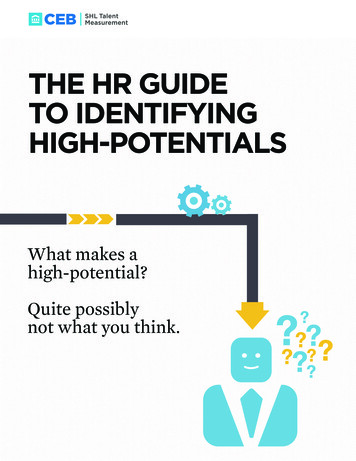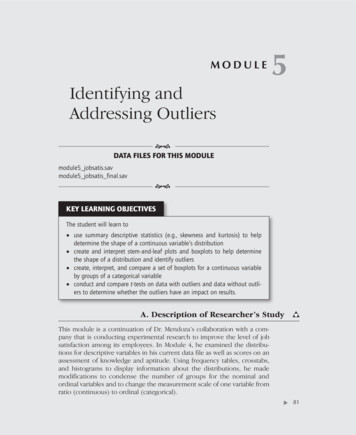
Transcription
THE HR GUIDETO IDENTIFYINGHIGH-POTENTIALSWhat makes ahigh-potential?Quite possiblynot what you think.Want to know more?Feel free to getin touch anytime.Tel: 800-899-7451www.ceb.shl.com/us/HiPoThe HR Guide to Identifying High-PotentialsChapter 1 - Introduction1
If you agree people areyour most valuable assetthen you need to know thathigh-potentials (HiPos) arean even more valuable asset.In fact, according to ourresearch a HiPo is twice asvaluable to an organization.HiPo: WHY THE STAKES ARE SO HIGHOrganizations with stronger leaders can show twice the revenue andtwice the profit growth. Yet a HiPo program, seen by many organizationsworldwide as the feeder to its leaders of the future, is statistically morelikely to fail than succeed – 50% of HR managers lack confidence in theirprograms and a staggering 5 in 6 HR managers are dissatisfied with theresults of their programs.Research covering a decade of assessments and recent analysis using theCEB analytics database of 6.6m has revealed that:50%Want to know more?OF HR PROFESSIONALS LACK CONFIDENCEFeel free to getIN THEIR HiPo PROGRAMin touch anytime.Tel: REVENUE AND PROFIT GROWTH FORORGANIZATIONS WITH A STRONGERLEADERSHIP STRENGTH2Chapter 1 - Introduction5 6OUTOFHR PROFESSIONALS ARE DISSATISFIEDWITH THEIR HiPo PROGRAMThe HR Guide to Identifying High-Potentials
55%WILL DROP OUT OFTHE HiPo PROGRAMWITHIN 5 YEARS46%OF LEADERS FAIL TO MEETTHEIR BUSINESS OBJECTIVESIN A NEW ROLEAT LEAST1 IN 7Potentially, this means much of yourinvestment in a HiPo program is atbest wasted and, at worst, feedingyour competitors with some of yourmost highly valuable people.PEOPLE ARE WRONGLY PUT ONTHE PROGRAM IN THE FIRST PLACEWant to know more?Feel free to getin touch anytime.Tel: 800-899-7451www.ceb.shl.com/us/HiPoIf you’re reading this guide, chancesare you’re an HR professional whoappreciates that making the right choices throughout your HiPo program is thekey to making it a success.The first step is to lay a solid foundation and identify the right candidates.This eBook provides you with revealing and shocking statistics about HiPoprograms, showing why access to the right data is fundamental to making theright choices. After all, it will provide a talent pool of future business leaders,with the capacity to run your organization.The HR Guide to Identifying High-PotentialsChapter 1 - Introduction3
Whether you are still exploring the idea of introducing a HiPo program toyour organization and want to understand how you can identify the rightcandidates, or you are looking to optimize your HiPo identification process,this eBook can serve as your helpful guide.By establishing how to identify your true high-potentials and how to run asuccessful HiPo identification program, this eBook will take you through thesteps you need to know. This guide will take you through solving potentialproblems and understanding the important role HR has to play in the successof identifying HiPos.It will also outline how HR can start to reframe the HiPo conversation withsenior management and introduce data-driven identification, as the first stepto turn intentions into actions.High-potential versus highperformance – why thedifference matters.Did you know that only onein seven high performersare actually high-potentialemployees?Want to know more?Feel free to getin touch anytime.Tel: 800-899-7451www.ceb.shl.com/us/HiPoIt’s true. So why then do many organizations still make the wrongassumption – that a high performer is also a high-potential? One of theproblems is that managers are putting forward staff for a HiPo programwithout having a robust identification process in place. As a result candidatesare being nominated for subjective reasons and not scientific reasons.But it doesn’t have to be this way. HR managers can now have access to thetools and information that can transform the identification stage of HiPo4Chapter 2 - High-Potential Versus High PerformanceThe HR Guide to Identifying High-Potentials
programs. This will ensure the program is worthy of its investment, createscompetitive advantage and produces a source of future leaders – but toachieve this you need a proven systematic approach.ARE YOU NOMINATING FOR THE RIGHT REASONS?“In some cases HiPos are not being selected with valid or structured reasoningin mind. While selecting individuals on the basis of high performance isn’tunheard of, in the worst case selection can be simply based on:It’s your turn. You’ve been here longenough, you’ve done a reasonable job, sowe’re going to put you on the program.If you consider that only 1 in 3 organizations are using hard assessment datato identify their potential, it’s not surprising the nomination process can beunclear.“Without a clear set of criteria, why would you be surprised a program fails? Toquote Albert Einstein:Insanity: doing the same thing over andover again and expecting different results.If you carry on doing the same thing, why would you expect anything tochange?TYPICAL ISSUES YOU’LL UNCOVER WHEN A HiPo PROGRAM STARTSTO GO WRONGWant to know more?Feel free to getin touch anytime.Tel: 800-899-7451www.ceb.shl.com/us/HiPoThe problems caused when a HiPo Program starts to go wrong don’t justaffect HR or the employees on the program. It spreads right through theorganization.Here are some issues being discussed by HR managers and colleagues thatmight sound familiar in organizations where the HiPo program is failing todeliver: Business leaders and HR are unconvinced that the right people are goingon the program but they have no structured answer to the issueThe HR Guide to Identifying High-PotentialsChapter 2 - High-Potential Versus High Performance5
The HR manager or line manager is not convinced the existing program isproducing the goods A lot of people simply don’t make it through the program Individual performance isn’t meeting business objectives and some HiPosare unable to work at the level and pace that the assignment requires People identified as HiPos are leaving the organization People are being identified as HiPos with highly subjective information e.g.preferences of managers or based on tenure with the organizationHOW DO YOU IDENTIFY THE RIGHT CANDIDATES FOR YOUR HiPo PROGRAM– IT’S TIME TO INTRODUCE YOU TO THE THREE COMPONENTSIt’s about understanding your employees better. What you really need toknow is: The risk that candidates will fail to achieve a senior position.The risk you don’t produce the quality of employee who will be effective ina more senior roleThe risk of diluting your benchstrength through people leaving and goingto the competitionIn-depth analysis and research has clearly highlighted three majorcomponents that highly correlate to identifying the right candidates: AspirationAbilityEngagementThese three components have proven to be robust in identifying true HiPos whether you’re in the banking sector in Hong Kong or in retail in New York.Want to know more?Feel free to getin touch anytime.By assessing the ability, aspiration and engagement of your HiPos, it makesyour odds of success much greater. By looking at these three components youhave a structured, scalable and practical framework for your selection process.Tel: 800-899-7451www.ceb.shl.com/us/HiPo6Chapter 2 - High-Potential Versus High PerformanceThe HR Guide to Identifying High-Potentials
IDENTIFYING HIPOS : THE THREE COMPONENTSEXPLORED10 years of data shows there is a way to choosethe right HiPo.ASPIRATIONENGAGEMENTHiPo1. Aspiration- To rise to senior roles2. Ability- To be effective in more responsible andsenior roles3. Engagement- To commit to the organizationand remain in challenging rolesABILITYWant to know more?Feel free to getin touch anytime.Tel: 800-899-7451www.ceb.shl.com/us/HiPo“A HiPo employee is a proven high performer withthree distinguishing attributes that allow them torise and succeed in more senior, critical positions:Remember this statistic? Only one in seven highperformers is a HiPo. So while high performance isa starting point for identifying candidates, you thenneed to assess these individuals for their aspiration,ability and engagement to establish who is a HiPo: Assess for aspiration and critical career management behaviors tounderstand if an employee will rise to a senior and more challengingposition and turn that motivation into career success Assess for future managerial and leadership ability to know whether theemployee has the competencies required for success in more senior andchallenging roles Evaluate engagement to know whether the employee is committed to theorganization and sees the organization as the best place to realize theircareer goalsDOES YOUR HiPo HAVE THE ASPIRATION TO BE A HiPo?After analyzing 18 motivational factors it was these six that were found todrive the achievement of an executive position:Does the employee have the motivational profile toreach a senior position and the behavioral profile toturn that motivation into tangible career success? Immersion: they look for roles that require a personal commitment abovethe normThe HR Guide to Identifying High-PotentialsChapter 2 - High-Potential Versus High Performance7
Activity: they prefer fast-paced, multi-tasking work environments Power: they want the opportunity to exercise, influence and shape howthings are done Interest: they look for roles and assignments that provide variety andstimulation Flexibility: they seek out work environments that allow them more fluidways of working Autonomy: they are attracted to roles that allow them autonomy in howthey execute their responsibilities.These motivations contribute to aspiration when the employee also exhibitsthe following behaviors:MOTIVATIONBEHAVIORTHE ACTIONS THATTHE INHERENT DRIVERSINDIVIDUALSTHAT FUEL SUCCESSTAKE THAT PROMOTETHE LIKELIHOOD OFACHIEVING A SENIORPOSITIONCAREER SUCCESS Using Initiative & Taking Responsibility: they are willing to takecalculated risks to realize an opportunity and assume positions ofresponsibility through which they can coordinate and impact on tasks,projects and objectives. Achieving Objectives & Pursuing Self-Development: they push forresults and are willing to invest in their personal development.Want to know more?Feel free to getin touch anytime.Tel: 800-899-7451www.ceb.shl.com/us/HiPoCHANGE IN THE ODDS OF SUCCESSOur analysis shows that these behavioral markers combined with the sixcritical motivational drivers increase the odds of achieving an executiveposition dramatically – by a factor of 11.1210.6X84.1X41X2X0Q1(LOWEST QUARTILE)Q2Q3Q4(HIGHEST QUARTILE)MOTIVATION BEHAVIORS (OVERALL METRIC)8Chapter 2 - High-Potential Versus High PerformanceThe HR Guide to Identifying High-Potentials
WHY ABILITY IS ONE OF THE IMPORTANT COMPONENTSTo fully understand this factor a clear definition of the attributes for someone’spotential to be an effective manager and leader is required. Effectivemanagers and leaders know how to: DEVELOP a compelling vision that is based on clear and critical thinking. ARTICULATE and communicate goals that motivate others and providedirection. COMMUNICATE effectively and support others through change. GET THINGS DONE and realize tangible goals and objectives.These talents are both the transactional (managerial) and the transformational(leadership) roles required of leaders and managers to ensure thatorganizations have direction, share common objectives, collaborate to achieveand, finally, deliver their strategic goals.The diagram below shows why you need a deeper understanding of ability.Organizations often target early career professionals with 10 years or lessexperience for their HiPo programs. However, at this stage of their careers, thespread of ability is often ranked at very-low to low levels of overall leadershippotential, while only 1 in 4 rank at the high to very high levels.It’s important, therefore, to identify the 1 in 4 within your organization.1 IN 2401 IN 4PERCENTAGE3020Want to know more?Feel free to getin touch anytime.10Tel: 800-899-7451www.ceb.shl.com/us/HiPo0VERY LOWLOWMODERATEHIGHVERY HIGHSHL TALENT MEASUREMENT SOLUTIONS LEADERSHIP BENCHMARKALL PROFESSIONALS WITH 10 YEARS OR LESS EXPERIENCEThe HR Guide to Identifying High-PotentialsChapter 2 - High-Potential Versus High Performance9
Nurturing lower scoring candidates for more specialist roles becomes a secondplan of learning and development for the HR team. Here the HiPo programis informing potential but re-routing the candidate for training and furtherconsideration in the future.WHO HAS THE ENGAGEMENT? THE THIRD ESSENTIAL COMPONENTIt’s all very well that your candidates are high performers, they are full ofaspiration and they demonstrate ability, but what next?HiPos with low engagement are prone to flight from the organization. Anda staggering 55% will drop out of the HiPo program. You need to qualifyengagement. Engagement is the strongest indicator that a HiPo will stay withthe organization.HIGHABILITYTHE NOT-SO HIDDEN RISKS OF LOWENGAGEMENTLacksAspirationLOWEngagement‘Who will stay?’HIGHASPIRATIONHigher RiskLower ReturnLacksAbilitySo now who wants to go and see the CEOand tell them that half of the top talent in thecompany is likely to leave within 5 years?Now you know about it, you can take the leadand do something about it.in touch anytime.Tel: AGEFeel free to getPERCENTAGELOWWant to know more?By contrast, nearly 60% of high-potentialemployees with high engagement levels have ahigh intent to stay – more than double that ofhigh-potential employees with lower levels 1Q42012Q42013EMPLOYEES WITH HIGH INTENT TO STAY1059%Chapter 2 - High-Potential Versus High Performance0LOW ENGAGEMENT HIGH ENGAGEMENTHiPosHiPosEMPLOYEES WITH HIGH INTENT TO STAYThe HR Guide to Identifying High-Potentials
Employee engagement is a concept that is widely accepted but looselydefined. An employee’s engagement is composed of two factors: Current Engagement, which is determined by a combination of pastexperiences with an employer (positive or negative) and their currentexperiences in their job, role and work environment Future Engagement, which is determined by their future expectationsabout their job, career and their employer, or what CEB calls EngagementCapital.CURRENT ENGAGEMENTHR needs to be an equal business partner in the day-to-day managementof HiPo programs. Every day the experiences, interactions with other staffand managers, the types of work and challenges that are set and thecultural impact of organizational goals and ethics, is making or breaking theengagement of the HiPo candidate.An employee is more likely to have strong current engagement when theirpast and current work fit their work preferences. Likewise, employees aremore likely to have future engagement when their organization’s mission,direction and values are aligned with their beliefs.ENGAGEMENT CAPITALTALENT OUTCOMESCURRENT CAPITALEmployees; emotional and rationalcommitment based on their perceptionof past and present experiencesFUTURE ENGAGEMENTWant to know more?Feel free to getin touch anytime.Employees; emotional and rationalcommitment based on their expectationsof their future employment experienceDiscretionary Effort& PerformanceIntent to StayRetentionTel: 800-899-7451www.ceb.shl.com/us/HiPoThe HR Guide to Identifying High-PotentialsChapter 2 - High-Potential Versus High Performance11
WHAT ARE YOUR PLANS FOR YOUR HiPo’s FUTURE? HOW DOES THIS MAPTO ENGAGEMENT?HiPos are in demand. Yes you want them, but then so does everyone else –including your competitors!So how the future looks and feels to the HiPo is important. They are going tobe as interested in their alignment with the organization’s mission and goalsas they are with their own personal challenges and goals.Identifying high-potential candidates with future engagement increasesthe likelihood that they will be engaged when placed in more challenging,complex and taxing senior roles. It also avoids the costs of losing thecandidate – remember the 55% that will likely leave or drop out of theprogram if you’re identifying the wrong people.INTRODUCE STRETCH ROLES TO ENGAGE AND RECOGNIZEYOUR HiPosNow you’re going to say “Hang on, 46% of HiPos fail in a new role.”Right?Yes, but that was also when you had the wrong people in the program. Right?The most effective high-potential programs, with the right people, arecentered on very visible, important and challenging stretch roles. These rolesplace individuals in assignments where their potential can be applied andrealized and they drive up organizational commitment and reduce the risk ofattrition.But you need to put in place the right support structure around the HiPo toprotect them - detecting failure and supporting them when it happens. Thismeans engaging with line of business, not just in the performance part of therole but also with a clear structure in the planned management of the role.Want to know more?Feel free to getin touch anytime.Tel: 800-899-7451www.ceb.shl.com/us/HiPo12Stretched roles have impact when they: Reinforce aspiration by talking to the key motivations that drive careersuccess, and when they build and reinforce the behaviors that translatemotivation into tangible career successChapter 2 - High-Potential Versus High PerformanceThe HR Guide to Identifying High-Potentials
Reinforce ability by targeting key skills and competencies that drivecompetitive advantage for the organization and are seen to develop theemployee and promote the longer-term success of the organization Reinforce engagement by demonstrating that staying with theorganization is in the employee’s best interests; it promotes careersuccess, matches development opportunities to personal career goals,and mitigates the potential for failure that comes with high-risk and highreturn assignments.High-potentials seek and value stretch assignments – and love the recognitionit brings.The CFO has a question foryou“Typically the person asking the difficult question is the CFO. They want toknow:If I put all this money into these programs today, how doI know I’m going to get a return on them in the future?It’s an issue for the HR manager and the CHRO, and this is where our modeladds value through its logic, practical application and the data that addressesthe key risks to your HiPo program.Everyone would agree that we need effective managers and leaders today andin the future - that is simple common sense.What your CFO might not know is that those organizations with strongerleadership benchstrength show up to two times the revenue and profit growthof organizations with weaker benchstrength.Want to know more?Feel free to getin touch anytime.Tel: 800-899-7451www.ceb.shl.com/us/HiPoSo, that’s the ROI issue - if we can identify, develop and retain high-potentialemployees, then that’s one factor that is clearly going to drive futureorganizational performance. Few would argue with that.Now here comes the power of the model. Any CFO will know that aninvestment carries risk, and your CFO might know the statsThe HR Guide to Identifying High-PotentialsChapter 3 - The CFO has a question for you13
we have shown about the likely success of HiPo programs as they are runtoday. But, you know the key risks and how they can be addressed.So, here’s how your conversation with the CFO could start “Okay, we’ve identified these three risks to our programs. Theseare the actions we’re taking, so back to that money you’reinvesting in the program, here is what we’re doing. We can’t giveyou an ROI today, but what we can show you, in a systematic way,is how we’re managing the risks to failure of these programs. Inparticular we’ll explain how we’re going to tighten the programup to make sure we get the right people on it.DOES HR HAVE AN IMPORTANT ROLE TO PLAY IN KEEPING HiPos FROMLEAVING, OR STOPPING THEM FROM DROWNING?The short answer is yes. But let’s look in more detail.First of all, there is a significant role for HR in supporting the line manager.The line manager is a critical factor for the overall success. If you’re a HiPowho is happy with your boss, you see your boss as someone who will supportyour development, who is there to encourage your success, who will enableyou to achieve your career goals. As a result you are much more likely tobind to the organization because you are more likely to be engaged with theorganization today and tomorrow.HR mustn’t fail to give managers the route map that helps them supportHiPos. The strong organizations are the ones where HR is working with themanagers so the managers can have a very focused, structured conversationwith the candidate, and they can agree what’s going to happen next.Want to know more?Secondly HR also has a responsibility to engage senior management, goingback to the C-suite and the CFO by making sure they’ve got the right kind ofday-to-day structure in place to manage those programs effectively.Feel free to getin touch anytime.Tel: 800-899-7451www.ceb.shl.com/us/HiPo14Chapter 3 - The CFO has a question for youThe HR Guide to Identifying High-Potentials
It’s about ensuring they have confidence in the program and knowing they cananswer all the fundamental questions: Are you putting the right people on the program? Do they have a clear set of priorities for learning and development? Why are we investing in this development spend for these people?WHAT IS THE IMPACT OF GOOD HR?When you compare your people to your competitors, either globally or locally,can you identify any gaps? By investing in the gaps you can lift the benchstrength and improve your competitiveness in the marketplace. These areelements at the micro and the macro level that good HR has a really bigimpact on.Part of that is supporting the manager, but part of that also is having the rightkind of data to give you an overview and give information back to the C-suiteto show: That the right people are going on the programHow they are being tracked through the programHow we manage the attrition rateHow we manage the leaving rateAlso, line manager feedback is important in terms of the satisfaction whenthey’re receiving candidates into their teams. Find out what the data is saying.When HiPos step into these leadership roles, are they perceived to be stronger,more able? That’s the other key function that HR should be performing.Maybe you find you need to step away from the ‘labels’ often attached to HiPoprograms and focus more on the operational processes and having the rightkind of data to answer the right kind of questions, and be proactive.Want to know more?Feel free to getin touch anytime.Tel: 800-899-7451www.ceb.shl.com/us/HiPoThe HR Guide to Identifying High-PotentialsChapter 3 - The CFO has a question for you15
HiPo IDENTIFICATION: THE HR MANAGER’S TO DO LISTOk, so what are the next steps?Imagine you’re responsible for the performance of the HiPo program(assuming you’re not already). You’re building the leadership bench andcreating the competitive advantage you need for the future. You’re giving theorganization the best chance to achieve revenue and profit growth and avoidthe mistakes of ordinary companies who let talent slip away.Want to know more? Get high performance as the sole criteria for consideration off theagenda! Do it now Create a plan to review every candidate on the HiPo program and reassess each candidate Carry out a talent audit on your existing candidates and extend theaudit to other high performers to check you didn’t miss anyone (especiallyif you suspect you’re using subjective criteria) Establish a feedback mechanism with your line of business and getthese business leaders ready to offer support and develop stretch roles Communicate clearly with managers. Outline challenges they may facewith HiPos already in their teams, and those that are coming their way Go to the CEO and the CFO armed with all the statistics about HiPosand explain that you’re going to carry out a comprehensive review basednot only on high performance, but also ability, aspiration and engagement Explain that you’re going to create a data-driven robust process toidentify your HiPos Use the new analysis from your talent audit to create new understandingabout those people on the HiPo program today, and who should actually beon the programFeel free to getin touch anytime.Tel: 800-899-7451www.ceb.shl.com/us/HiPo16Chapter 3 - The CFO has a question for youThe HR Guide to Identifying High-Potentials
Improve your odds ofsuccess. Remember thestakes are high.HiPo programs are not delivering. You may have known thatalready, but you certainly know the statistics now.Those statistics don’t need to be the ones you experience withyour programs. Our model and our tools, based on working withleading organizations worldwide, will change the odds in favor of thesuccess for your programs.Having clear, objective data that tells you whether your candidateshave the aspiration, ability and engagement to drive the success ofyour programs will put you and your organization in control of thoseodds.Want to know more?Feel free to getin touch anytime.Tel: 800-899-7451www.ceb.shl.com/us/HiPoThe HR Guide to Identifying High-PotentialsChapter 3 - The CFO has a question for you17
Want to know more?Feel free to getin touch anytime.Tel: 800-899-7451www.shl.com/us/hipo 2014 SHL, a part of CEB. All rights reserved.
senior management and introduce data-driven identification, as the first step . to turn intentions into actions. High-potential versus high . performance – why the difference matters. Did you know that only one in seven high performers . are actually high-potential employees? It’s tru











